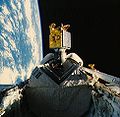STS-51-I
This article includes a list of references, related reading, or external links, but its sources remain unclear because it lacks inline citations. (May 2008) |
| COSPAR ID | 1985-076A |
|---|---|
| SATCAT no. | 15992 |
| End of mission | |

 | |
STS-51-I was a Space Shuttle Discovery mission that deployed three communications satellites. The mission launched from Kennedy Space Center, Florida on August 27, 1985.
Crew
Number in parentheses indicates number of spaceflights by each individual prior to and including this mission.
- Joseph H. Engle (2) - Commander
- Richard O. Covey (1) - Pilot
- James D. A. van Hoften (2) - Mission Specialist
- John M. Lounge (1) - Mission Specialist
- William F. Fisher (1) - Mission Specialist
Mission parameters
- Mass:
- Orbiter Liftoff: 262,308 lb (118,981 kg)
- Orbiter Landing: 196,670 lb (89,208 kg)
- Payload: 43,987 lb (19,952 kg)
- Perigee: 351 km
- Apogee: 364 km
- Inclination: 28.5°
- Period: 91.7 min
Space walks
- Fisher and van Hoften - EVA 1
- EVA 1 Start: August 31, 1985
- EVA 1 End: August 31, 1985
- Duration: 7 hours, 20 minutes
- Fisher and van Hoften - EVA 2
- EVA 2 Start: September 1, 1985
- EVA 2 End: September 1, 1985
- Duration: 4 hours, 26 minutes
Mission highlights
The orbiter Discovery flew the 20th space shuttle mission starting with its launch at 6:58 a.m. EDT, August 27, 1985. Two earlier launch attempts, one on August 24 and another on August 25 were scrubbed — the first because of poor weather and the second because the backup orbiter computer failed and had to be replaced. The successful August 27 launch took place just as an approaching storm front reached the launch pad area.
The five-man STS 51-I crew included Joe H. Engle, commander; Richard O. Covey, pilot; and three mission specialists James van Hoften, John M. Lounge and William F. Fisher. Their primary mission was to deploy three commercial communications satellites and retrieve and repair SYNCOM IV-3 which was deployed during the STS 51-D mission in April 1985 and had malfunctioned. In addition, a middeck materials processing experiment was flown.
The three communications satellites included AUSSAT-l, a multi-purpose spacecraft owned by Australia; the ASC-l owned and operated by the American Satellite Co.; and SYNCOM IV-4 leased to the Department of Defense by its builder, the Hughes Co. Both AUSSAT-l and ASC-l were deployed on launch day, August 27. IV-4, was deployed two days later. All three achieved proper geosynchronous orbits and became operational.
On the fifth day of the mission, astronauts Fisher and van Hoften began repair efforts on the malfunctioning IV-3 following a successful rendezvous maneuver with Discovery. The effort was slowed because of a problem in the RMS elbow joint. In any event, after a second EVA by Fisher and van Hoften, the lever was repaired, permitting commands from the ground to activate the spacecraft's systems and eventually sending it into its proper geosynchronous orbit. The two EVAs took 11 hours and 27 minutes.
Discovery landed on Runway 23 at Edwards AFB at 6:16 a.m. PDT on September 3. The flight took 7 days, 2 hours, 18 minutes, 42 seconds, completing 111 orbits of the Earth.
The three communications satellites deployed were: ASC-1, for American Satellite Company; AUSSAT-1, an Australian Communications Satellite; and SYNCOM IV-4, the Synchronous Communications Satellite. ASC-1 and AUSSAT-1 both attached to Payload Assist Module-D (PAM-D) motors. SYNCOM IV-4 (also known as LEASAT-4) failed to function after reaching correct geosynchronous orbit. Fisher and van Hoften performed 11 hours, 27 minutes of space walk. Part of time spent retrieving, repairing and redeploying LEASAT-3, deployed on Mission 51-D. Middeck Payload: Physical Vapor Transport Organic Solid Experiment (PVTOS).
Gallery
-
Deployment of AUSSAT-1
-
Deployment of ASC-1
-
Deployment Syncom IV-4
-
Hoften works on Syncom IV-3
See also
- Space science
- Space shuttle
- List of space shuttle missions
- List of human spaceflights chronologically
External links





